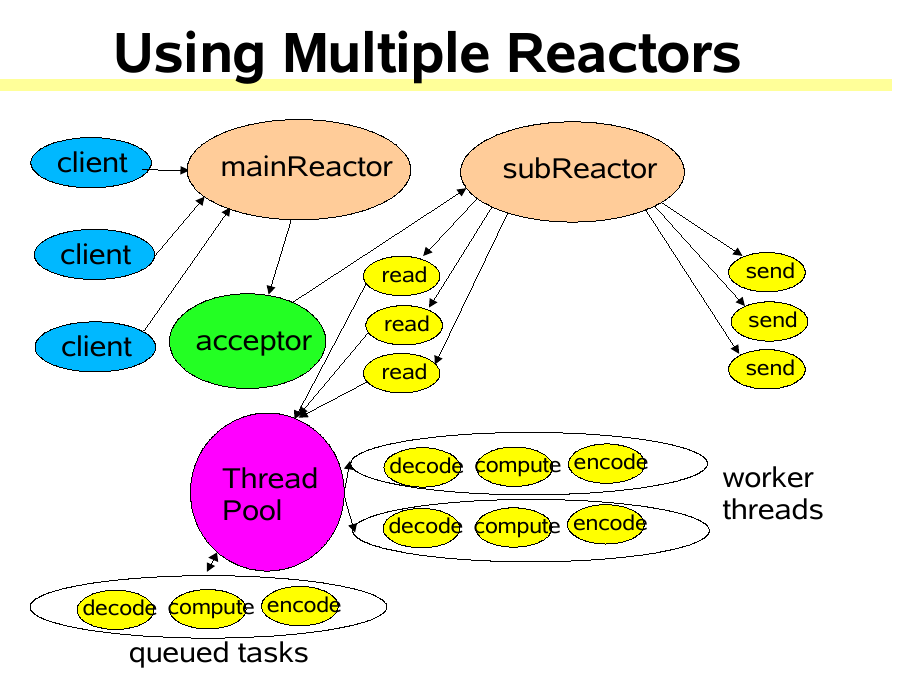I/O模型总结
大约 3 分钟
1 BIO
当给BIO的accept和read方法加上超时机制后,可以在代码层面解决阻塞问题,但这不是真正的非阻塞,通常我们说的非阻塞是指的操作系统层面的非阻塞,就是当accept通过jni调用native方法后,最终系统不会一直被阻塞。真正的非阻塞是操作系统增加非阻塞功能后,java同步添加java.nio出现以后才有的,因此通过java实现非阻塞,需要调用nio中的类。
2 NIO
3 IO多路复用
4 异步IO
5 事件驱动的io
6 reactor线程模型
reactor线程模型可参考Scalable IO in java,该书作者也是java.nio的作者
注意
注意reactor线程模型并不是5种io模型之一,它是一种经典的事件驱动的线程模型,它是基于IO多路复用模型衍生出来的:
Reactor线程模式 = Reactor(I/O多路复用)+ 线程池
Reactor负责监听和分配事件,线程池负责处理事件
根据Reactor的数量和线程池的数量,又可以将Reactor分为三种模型
- 单Reactor单线程模型 (固定大小为1的线程池)
- 单Reactor多线程模型
- 多Reactor多线程模型 (一般是主从2个Reactor)
reactor模型中有三种角色,分别是:
Acceptor:处理客户端新连接,并分派请求到处理器链中
Reactor:负责监听和分配事件,将I/O事件分派给对应的Handler
Handler: 事件处理,如编码、解码等
6.1 单reactor单线程
应用:redis4.0

源码示例:
//------------------------reactor------------------
import java.io.IOException;
import java.net.InetSocketAddress;
import java.nio.channels.SelectionKey;
import java.nio.channels.Selector;
import java.nio.channels.ServerSocketChannel;
import java.nio.channels.SocketChannel;
import java.util.Iterator;
import java.util.Set;
class Reactor implements Runnable {
final Selector selector;
final ServerSocketChannel serverSocket;
Reactor(int port) throws IOException {
selector = Selector.open();
serverSocket = ServerSocketChannel.open();
serverSocket.socket().bind(
new InetSocketAddress(port));
serverSocket.configureBlocking(false);
SelectionKey sk =
serverSocket.register(selector,
SelectionKey.OP_ACCEPT);
System.out.println("listen to " + port );
sk.attach(new Acceptor());
}
/*
Alternatively, use explicit SPI provider:
SelectorProvider p = SelectorProvider.provider();
selector = p.openSelector();
serverSocket = p.openServerSocketChannel();
*/
// class Reactor continued
public void run() { // normally in a new Thread
try {
while (!Thread.interrupted()) {
System.out.println("进入reactor run");
selector.select();
Set selected = selector.selectedKeys();
Iterator it = selected.iterator();
while (it.hasNext())
dispatch((SelectionKey) (it.next()));
selected.clear();
}
} catch (IOException ex) { /* ... */ }
}
void dispatch(SelectionKey k) {
System.out.println("进入reactor dispatch");
Runnable r = (Runnable) (k.attachment());
if (r != null)
r.run();
}
// class Reactor continued
class Acceptor implements Runnable { // inner
public void run() {
System.out.println("进入Acceptor run");
try {
SocketChannel c = serverSocket.accept();
if (c != null) {
new Handler(selector, c);
}
} catch (IOException ex) { /* ... */ }
}
}
}
//------------------------handler------------------
import java.io.IOException;
import java.nio.ByteBuffer;
import java.nio.channels.SelectionKey;
import java.nio.channels.Selector;
import java.nio.channels.SocketChannel;
final class Handler implements Runnable {
final SocketChannel socket;
final SelectionKey sk;
ByteBuffer input = ByteBuffer.allocate(1024);
ByteBuffer output = ByteBuffer.allocate(1024);
static final int READING = 0, SENDING = 1;
int state = READING;
Handler(Selector sel, SocketChannel c)
throws IOException {
System.out.println("进入handler 处理");
socket = c;
c.configureBlocking(false);
// Optionally try first read now
sk = socket.register(sel, 0);
sk.attach(this);
sk.interestOps(SelectionKey.OP_READ);
sel.wakeup();
}
boolean inputIsComplete() { /* ... */
return true;
}
boolean outputIsComplete() { /* ... */
return true;
}
void process() { /* ... */ }
// class Handler continued
public void run() {
try {
if
(state == READING) read();
else if (state == SENDING) send();
} catch (IOException ex) { /* ... */ }
}
void read() throws IOException {
socket.read(input);
if (inputIsComplete()) {
process();
state = SENDING;
// Normally also do first write now
sk.interestOps(SelectionKey.OP_WRITE);
}
}
void send() throws IOException {
socket.write(output);
if (outputIsComplete()) sk.cancel();
}
}
//-----------------------main-----
import java.io.IOException;
/**
* 单reactor单线程模型
*/
public class Main {
public static void main(String[] args) throws IOException {
Reactor reactor = new Reactor(6666);
new Thread(reactor).start();
}
}
6.2 单reactor多线程

6.3 主从(多)reactor多线程
应用:netty
